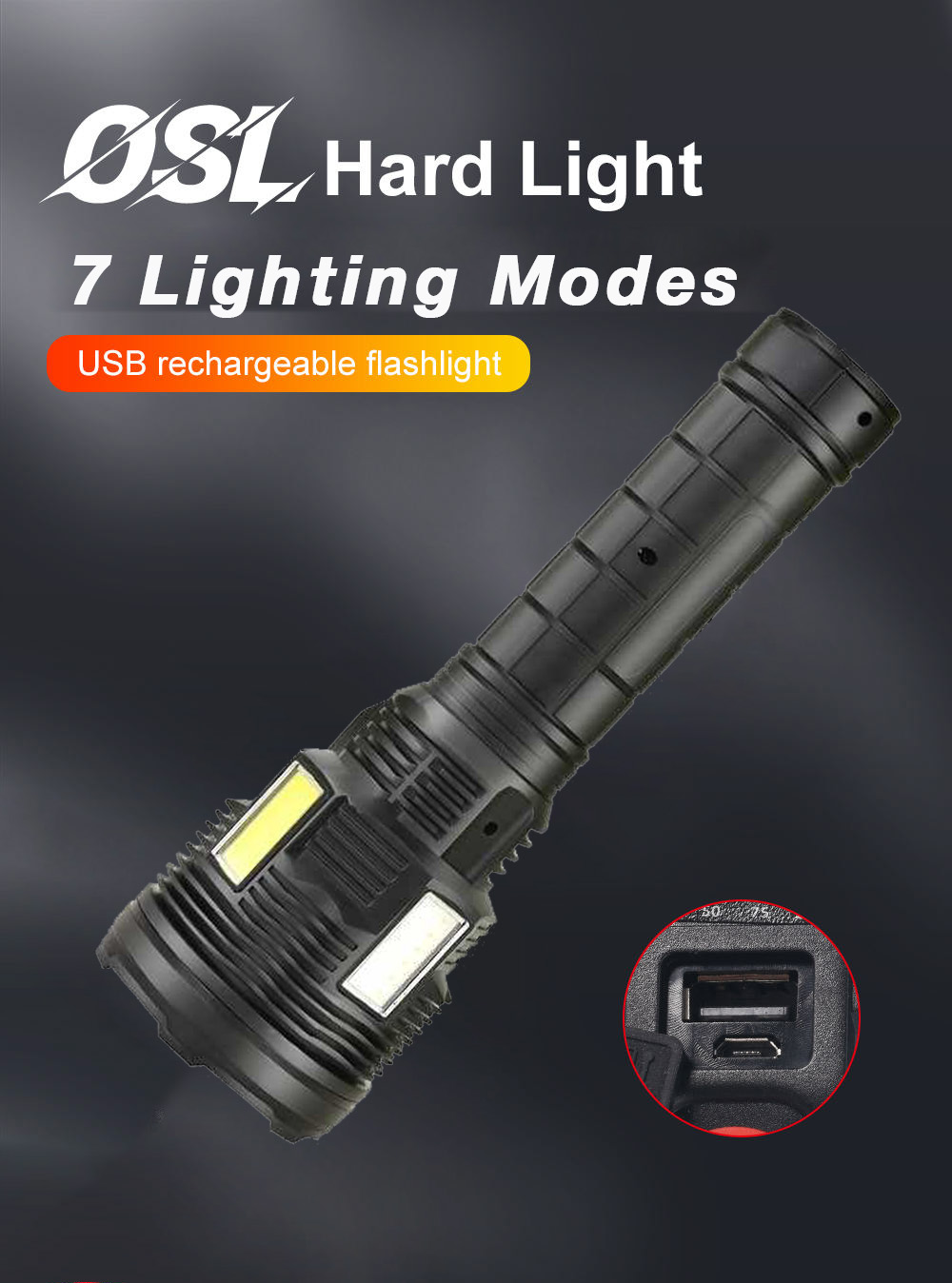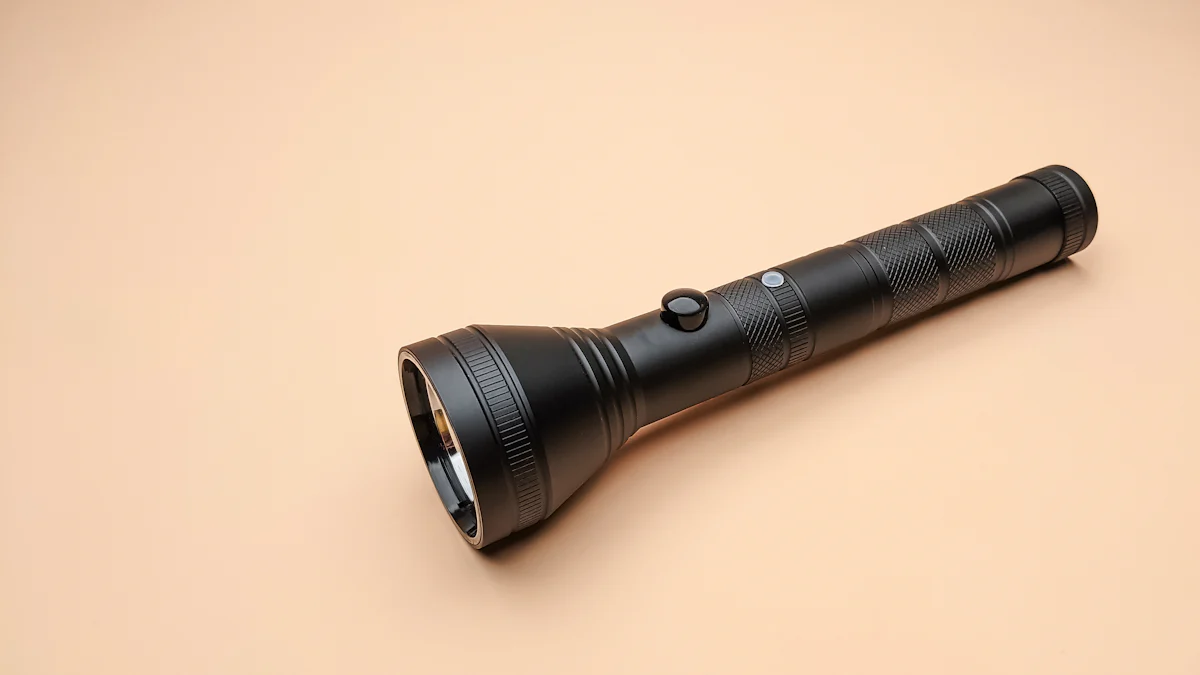Choosing a Flashlight for Your Vehicle Emergency Kit

A flashlight is one of the most important tools in your emergency car kit. Imagine breaking down at night or during a storm. You’ll need light to stay safe and handle the situation. The right emergency flashlight can make all the difference. It’s a small addition to your emergency kit but a huge step toward being prepared.
Key Takeaways
Pick a flashlight that is bright but saves battery power. It’s important to balance brightness and battery life.
Get a strong and weatherproof flashlight for emergencies. Look for tough materials like aluminum and rubber seals.
Test your flashlight often and take care of it. Check the batteries every month and keep extras in your kit.
Key Features of an Emergency Flashlight

Brightness and Lumens
When choosing an emergency flashlight, brightness is one of the most important factors. Brightness is measured in lumens, which indicate how much light the flashlight produces. For emergencies, you’ll want a flashlight with a lumen range that suits your needs. Here’s a quick reference:
Max Lumens |
|---|
2800 |
2000 |
21000 |
1700 |
1600 |
100 |
4000 |
300 |
Keep in mind, higher lumens mean brighter light, but they can also drain the battery faster. In low-light conditions, the human eye adapts to see better in blue light, making some flashlights more effective than others. A flashlight with adjustable brightness can help you balance visibility and battery life.
Battery Life and Power Source
Battery life is crucial during emergencies. You don’t want your flashlight dying when you need it most. Flashlights powered by lithium-ion batteries often last up to 3 hours of continuous use, while others, like lead-acid or nickel-cadmium, may only last 90 minutes. Here’s a breakdown:
Battery Type | Expected Illumination Duration |
|---|---|
Lead-Acid | Up to 90 minutes |
Nickel-Cadmium | Up to 90 minutes |
Lithium-Ion | Up to 3 hours |
For reliability, consider rechargeable lithium-ion batteries or CR123A batteries, which offer high capacity and long shelf life. Always keep a flashlight and extra batteries in your emergency kit.
Durability and Weather Resistance
Emergencies don’t wait for perfect weather. Your flashlight should handle rain, snow, or rough handling. Look for models made with anodized aluminum or stainless steel, which resist corrosion. Rubber gaskets and O-rings also help keep water out, ensuring your flashlight works when you need it most.
Size and Portability
A bulky flashlight might not fit well in your emergency car kit. Compact and lightweight options are easier to store and carry. However, don’t sacrifice functionality for size. Choose a flashlight that balances portability with performance.
Multifunctional Features (e.g., window breaker, seatbelt cutter)
Some emergency flashlights come with extra tools like a window breaker or seatbelt cutter. These features can be lifesavers in a car survival kit. Others include an emergency radio or even a portable jump starter. Having these essential supplies in one tool saves space and ensures you’re ready for anything.
Tip: Always test your flashlight before adding it to your emergency kit essentials. Make sure it works properly and meets your needs.
Types of Flashlights for a Car Emergency Kit
LED Flashlights
LED flashlights are a top choice for emergencies. They’re energy-efficient and produce bright light while using less power than traditional flashlights. You’ll also appreciate their durability—LED bulbs can last up to 50,000 hours, far outlasting the 1,000 to 2,000 hours of incandescent bulbs. While they might cost more upfront, their long lifespan saves you money in the long run.
Benefit | LED Flashlights | Traditional Flashlights |
|---|---|---|
Brightness | Up to 20,000 lumens | Around 1,800 lumens (100-watt bulb) |
Energy Efficiency | Consumes less power, reduces waste | Wastes energy through heat |
Lifespan | 50,000 hours | 1,000 to 2,000 hours |
Maintenance | Lower maintenance needs | Higher maintenance due to filament |
Hand-Crank Flashlights
Hand-crank flashlights are perfect for long-term emergencies. They don’t rely on batteries, so you’ll always have light when you need it. Just crank the handle to generate power. These flashlights are great for reducing waste since they don’t require disposable batteries. Their durability and self-powered design make them a reliable addition to your car survival kit.
Rechargeable Flashlights
Rechargeable flashlights are another excellent option. They’re cost-effective over time because you won’t need to buy replacement batteries. Plus, they’re eco-friendly and provide powerful lighting, thanks to high-capacity lithium batteries. However, they can be bulkier and need electricity to recharge, which might be a drawback during power outages.
Solar-Powered Flashlights
Solar-powered flashlights are ideal if you want a sustainable option. They use sunlight to recharge, making them perfect for daytime emergencies. While they might not work as well at night without prior charging, they’re a great backup option for your emergency kit.
Flashlights with Adjustable Brightness
Flashlights with adjustable brightness give you control over how much light you need. This feature helps conserve battery life during emergencies. Whether you’re changing a tire or looking for jumper cables in the dark, you can adjust the brightness to suit the situation.
Tip: Pair your flashlight with other essential supplies like water and non-perishable food to stay prepared for any survival scenario.
Practical Tips for Choosing the Right Flashlight
Match the Flashlight to Your Local Climate
Your local weather plays a big role in choosing the right emergency flashlight. If you live in a rainy or snowy area, pick a flashlight with strong weather resistance. Look for models labeled as waterproof or water-resistant. For hot climates, choose one made from materials that can handle high temperatures without damage. A durable flashlight ensures you’re ready for any emergency, no matter the weather.
Consider Storage Space in Your Vehicle
Space in your car survival kit is limited, so size matters. A compact flashlight fits easily without taking up too much room. However, don’t go too small. You still need a flashlight that’s powerful and reliable. If you’re tight on space, consider multifunctional options that combine tools like an emergency radio or a portable jump starter.
Test the Flashlight Before Adding It to Your Kit
Never assume a flashlight will work perfectly out of the box. Test it first. Check the brightness, battery life, and any additional features. Make sure it’s easy to operate, even in stressful situations. Keep flashlight and extra batteries in your emergency kit essentials to avoid surprises.
Look for Long Runtime and Energy Efficiency
A flashlight with a long runtime is crucial during emergencies. LED flashlights are a great choice because they’re energy-efficient and last longer. Adjustable brightness settings can also help conserve power. Pair your flashlight with essential supplies like water and non-perishable food to stay prepared.
Balance Budget with Quality and Features
You don’t have to spend a fortune, but don’t settle for the cheapest option either. Balance your budget with quality and features. A flashlight with adjustable brightness, weather resistance, and a sturdy build is worth the investment. It’s better to spend a little more now than regret it during an emergency.
Tip: Keep jumper cables and other tools handy alongside your flashlight to cover all your bases.
Maintenance and Storage of Your Emergency Flashlight
Regularly Check and Replace Batteries
To ensure your flashlight is always ready, you need to check and replace its batteries regularly. Test the batteries every month and perform a full functional test once a year. During this test, make sure the flashlight stays illuminated for at least 90 minutes. Replace the batteries immediately if they don’t perform well. Here’s a quick guide to battery replacement intervals:
Battery Type | Replacement Interval |
|---|---|
Lead-Acid Batteries | Every 2–3 years |
Nickel-Cadmium Batteries | Every 4–5 years |
Lithium-Ion Batteries | Every 5–7 years |
Tip: Always keep spare batteries in your emergency kit to avoid surprises during critical moments.
Store in a Cool, Dry, and Accessible Location
Where you store your flashlight matters. Hot or humid environments can cause battery leakage, corrosion, or even reduce battery life. In rare cases, overheated batteries might pose a fire risk. Keep your flashlight in a cool, dry spot that’s easy to access during an emergency. This will protect it from damage and ensure it’s ready when you need it most.
Inspect for Damage or Wear Periodically
Regular inspections can help you catch issues before they become problems. Look for visible damage on the flashlight body, especially around the bezel and lens. Check the O-ring seal for cracks or wear, as this can compromise its waterproofing. Also, inspect the tail and head for corrosion or dirt. If you notice any of these signs, it might be time to replace or repair your flashlight.
Clean the Flashlight to Maintain Performance
A clean flashlight works better and lasts longer. Follow these steps to keep it in top shape:
Wipe the exterior with a dry or slightly damp cloth.
Use a soft, lint-free cloth to clean the lens. Avoid abrasive materials that could scratch it.
Inspect the O-rings and replace them if needed to maintain waterproofing.
Check the reflector and bulb for dirt or damage. Clean or replace them as necessary.
Note: Always let the flashlight air dry completely after cleaning to prevent moisture buildup.
Keep Spare Batteries in Your Emergency Kit
Having spare batteries in your emergency kit is non-negotiable. Emergencies are unpredictable, and you don’t want to be caught off guard with a dead flashlight. Choose high-capacity batteries with a long shelf life, like lithium-ion or CR123A batteries. Pairing your flashlight with other essential supplies, like water and non-perishable food, ensures you’re fully prepared for any situation.
Pro Tip: Store your spare batteries in a separate, sealed container to protect them from moisture and accidental discharge.
A reliable flashlight is a must-have for your emergency kit. Focus on brightness, durability, and battery life to handle any emergency. Regular maintenance, like replacing batteries and cleaning, keeps it ready to go. Don’t wait—equip your car with a dependable flashlight today and stay prepared for the unexpected.
FAQ
What type of flashlight is best for an emergency kit?
LED flashlights are the best choice. They’re durable, energy-efficient, and provide bright light. Their long lifespan makes them perfect for your emergency kit.
How often should you check your emergency flashlight?
You should test your flashlight monthly. Replace batteries as needed and inspect for damage to ensure it’s ready for any roadside safety situation.
Can a flashlight replace other vehicle kit essentials?
No, a flashlight complements your kit. It works alongside tools like jumper cables and other emergency supplies to keep you prepared for unexpected situations.
See Also
A Homeowner's Guide to Selecting the Ideal Emergency Flashlight
Essential Advice for Picking the Perfect Camping Flashlight
Guidelines for Selecting the Best Headlamp Flashlight
